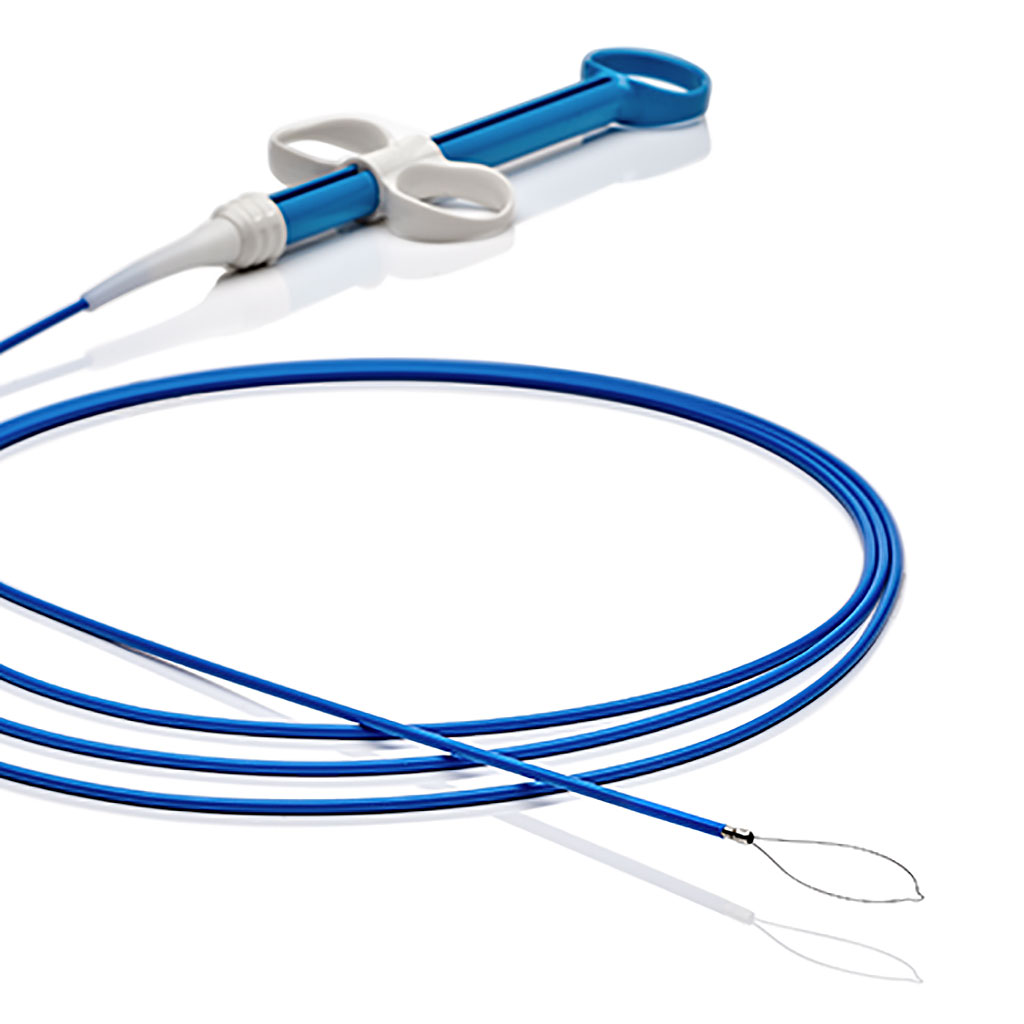Thin Wire Resector Advances Cold Snare Polypectomy
|
By HospiMedica International staff writers Posted on 30 Nov 2021 |

Image: The LesionHunter cold snare, with an ultra-thin Nitinol wire (Photo courtesy of Micro-Tech Endoscopy)
A novel cold snare features a rotatable thin Nitinol wire which provides clean, precise resection of diminutive polyps.
The Micro-Tech Endoscopy (Ann Arbor, MI, USA) LesionHunter is a thin (0.18 mm) Nitinol cold snare specifically designed for resecting sessile polyps, pedunculated polyps, and tissue from within the gastrointestinal (GI) tract. The thin cutting wire provides for a guillotine-type cut, while the loop shape assists in capturing smaller polyps. The coiled metal catheter is stiff in order to aid insertion through an extended scope position, while providing support during resection. A three-ring comfortable grip with shortened throw aids effortless cuts.
The thin wire may also reduce the risk of generating a “fly-away” specimen, thereby making it easier to find the tissue at the end of the resection, and reducing the risk of it being hidden at the back of colon folds. LesionHunter is available in oval 10 mm, 15 mm, and 20 mm widths, with all three having the same 230 cm length and 2.3 mm outer diameter.
“The LesionHunter nitinol wire is 61% thinner than traditional braided snare wires and 42% thinner than the most popular braided cold snare on the market,” said Scott Haack, global R&D director at Micro-Tech. “The thin Nitinol wire allows for multiple tissue resections while maintaining its shape along with the ability to make a clean cut through large pieces of tissue. Current dedicated cold snares and hybrid hot/cold snares can't consistently accomplish this.”
“The LesionHunter is a unique cold snare with two great features, the ability to trap the tissue regardless of how flat the lesion is, and the 'cheese cutter' capability to resect even larger lesions,” said gastroenterologist Gregory Haber, MD, of NYU Langone (NY, USA). “It has become my go-to for cold snare applications.”
Cold snares are emerging as the dominant strategy for excising diminutive polyps in the 4–10-mm range. Pedunculated polyps can also be resected using dedicated cold snare polypectomy, if the snare is large enough to reach the stalk below the polyp head. If submucosal tissue is entrapped in the snare, the captured tissue can be guillotined repeatedly to remove the polyp completely.
Related Links:
Micro-Tech Endoscopy
The Micro-Tech Endoscopy (Ann Arbor, MI, USA) LesionHunter is a thin (0.18 mm) Nitinol cold snare specifically designed for resecting sessile polyps, pedunculated polyps, and tissue from within the gastrointestinal (GI) tract. The thin cutting wire provides for a guillotine-type cut, while the loop shape assists in capturing smaller polyps. The coiled metal catheter is stiff in order to aid insertion through an extended scope position, while providing support during resection. A three-ring comfortable grip with shortened throw aids effortless cuts.
The thin wire may also reduce the risk of generating a “fly-away” specimen, thereby making it easier to find the tissue at the end of the resection, and reducing the risk of it being hidden at the back of colon folds. LesionHunter is available in oval 10 mm, 15 mm, and 20 mm widths, with all three having the same 230 cm length and 2.3 mm outer diameter.
“The LesionHunter nitinol wire is 61% thinner than traditional braided snare wires and 42% thinner than the most popular braided cold snare on the market,” said Scott Haack, global R&D director at Micro-Tech. “The thin Nitinol wire allows for multiple tissue resections while maintaining its shape along with the ability to make a clean cut through large pieces of tissue. Current dedicated cold snares and hybrid hot/cold snares can't consistently accomplish this.”
“The LesionHunter is a unique cold snare with two great features, the ability to trap the tissue regardless of how flat the lesion is, and the 'cheese cutter' capability to resect even larger lesions,” said gastroenterologist Gregory Haber, MD, of NYU Langone (NY, USA). “It has become my go-to for cold snare applications.”
Cold snares are emerging as the dominant strategy for excising diminutive polyps in the 4–10-mm range. Pedunculated polyps can also be resected using dedicated cold snare polypectomy, if the snare is large enough to reach the stalk below the polyp head. If submucosal tissue is entrapped in the snare, the captured tissue can be guillotined repeatedly to remove the polyp completely.
Related Links:
Micro-Tech Endoscopy
Latest Surgical Techniques News
- New Study Findings Could Halve Number of Stent Procedures
- Breakthrough Surgical Device Redefines Hip Arthroscopy
- Automated System Enables Real-Time "Molecular Pathology" During Cancer Surgery
- Groundbreaking Procedure Combines New Treatments for Liver Tumors
- Ablation Reduces Stroke Risk Associated with Atrial Fibrillation
- Optical Tracking Method Identifies Target Areas in Robot-Assisted Neurosurgery
- General Anesthesia Improves Post-Surgery Outcomes for Acute Stroke Patients
- Drug-Coated Balloons Can Replace Stents Even in Larger Coronary Arteries
- Magnetic Kidney Stone Retrieval Device Outperforms Ureteroscopic Laser Lithotripsy
- Absorbable Skull Device Could Replace Traditional Metal Implants Used After Brain Surgery
- Magic Silicone Liquid Powered Robots Perform MIS in Narrow Cavities
- 'Lab-on-a-Scalpel' Provides Real-Time Surgical Insights for POC Diagnostics in OR
- Biodegradable Brain Implant Prevents Glioblastoma Recurrence
- Tiny 3D Printer Reconstructs Tissues During Vocal Cord Surgery
- Minimally Invasive Procedure for Aortic Valve Disease Has Similar Outcomes as Surgery
- Safer Hip Implant Design Prevents Early Femoral Fractures
Channels
Critical Care
view channel
Magnetically Guided Microrobots to Enable Targeted Drug Delivery
Stroke affects 12 million people globally each year, often causing death or lasting disability. Current treatment relies on systemic administration of clot-dissolving drugs, which circulate throughout... Read more
Smart Nanomaterials Detect and Treat Traumatic Brain Injuries Simultaneously
Traumatic brain injury (TBI) continues to leave millions with long-term disabilities every year. After a sudden impact from a fall, collision, or accident, the brain undergoes inflammation, oxidative stress,... Read more
Earlier Blood Transfusion Could Reduce Heart Failure and Arrhythmia in Heart Disease Patients
Blood loss during or after surgery can place significant stress on people with heart disease, increasing the risk of dangerous complications. Transfusions are often delayed until hemoglobin levels fall... Read morePatient Care
view channel
Revolutionary Automatic IV-Line Flushing Device to Enhance Infusion Care
More than 80% of in-hospital patients receive intravenous (IV) therapy. Every dose of IV medicine delivered in a small volume (<250 mL) infusion bag should be followed by subsequent flushing to ensure... Read more
VR Training Tool Combats Contamination of Portable Medical Equipment
Healthcare-associated infections (HAIs) impact one in every 31 patients, cause nearly 100,000 deaths each year, and cost USD 28.4 billion in direct medical expenses. Notably, up to 75% of these infections... Read more
Portable Biosensor Platform to Reduce Hospital-Acquired Infections
Approximately 4 million patients in the European Union acquire healthcare-associated infections (HAIs) or nosocomial infections each year, with around 37,000 deaths directly resulting from these infections,... Read moreFirst-Of-Its-Kind Portable Germicidal Light Technology Disinfects High-Touch Clinical Surfaces in Seconds
Reducing healthcare-acquired infections (HAIs) remains a pressing issue within global healthcare systems. In the United States alone, 1.7 million patients contract HAIs annually, leading to approximately... Read moreHealth IT
view channel
Printable Molecule-Selective Nanoparticles Enable Mass Production of Wearable Biosensors
The future of medicine is likely to focus on the personalization of healthcare—understanding exactly what an individual requires and delivering the appropriate combination of nutrients, metabolites, and... Read moreBusiness
view channel
Philips and Masimo Partner to Advance Patient Monitoring Measurement Technologies
Royal Philips (Amsterdam, Netherlands) and Masimo (Irvine, California, USA) have renewed their multi-year strategic collaboration, combining Philips’ expertise in patient monitoring with Masimo’s noninvasive... Read more
B. Braun Acquires Digital Microsurgery Company True Digital Surgery
The high-end microsurgery market in neurosurgery, spine, and ENT is undergoing a significant transformation. Traditional analog microscopes are giving way to digital exoscopes, which provide improved visualization,... Read more
CMEF 2025 to Promote Holistic and High-Quality Development of Medical and Health Industry
The 92nd China International Medical Equipment Fair (CMEF 2025) Autumn Exhibition is scheduled to be held from September 26 to 29 at the China Import and Export Fair Complex (Canton Fair Complex) in Guangzhou.... Read more














